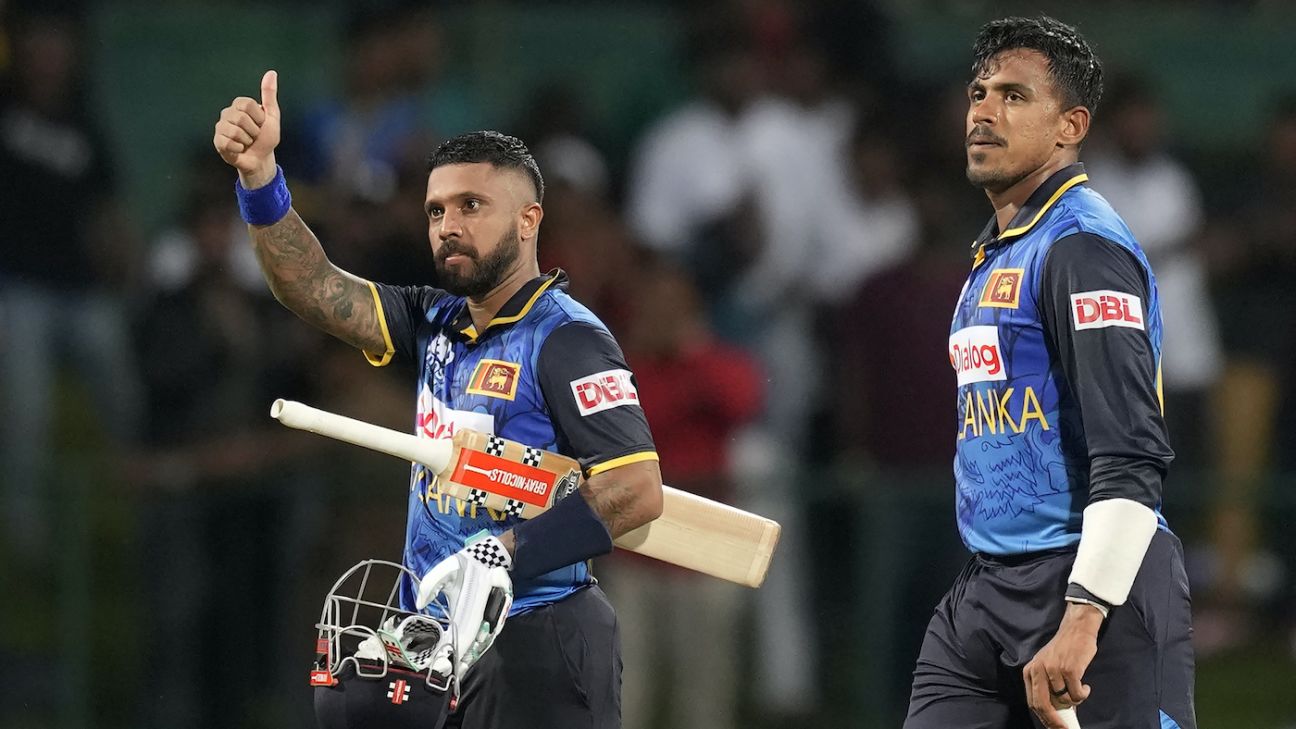Sri Lanka 210 for 7 (Mendis 74*, Theekshana 27*, Bracewell 4-36) beat New Zealand 209 all out (Chapman 76, Hay 49, Theekshana 3-31) by three wickets (47 overs a side)
But on a surface where nearly every spinner proved threatening to some degree, it was always going to take a special batting effort to separate the two sides. And Kusal provided that in spades.
Having come into bat at the fall of the first wicket inside the fifth over, it wasn’t long before Kusal decided on a more conservative approach. The first ball he faced spun sharply past his forward defence, and then an attempt at his escape shot – the slog sweep – saw a top edge that looped safely over the keeper.
A couple of overs later Kusal was under the microscope once more, after a tight lbw shout went in his favour – a decision that was only upheld on review courtesy of an umpire’s call on impact. These nervy moments meant that Kusal wouldn’t get his first boundary until the 26th delivery he faced. In fact, in total across his innings he would score just the six boundaries; instead, this was an innings marked more by his grit, with 46 singles and two doubles – 67% of his runs – an abnormally high percentage of non-boundary runs for a Kusal Mendis innings.
That he did so while struggling with cramps, or quite possibly a groin strain, for most of his innings speaks volumes towards his effort on the night.
But this was not a match Mendis could have won on his own. Aside from five-run stand with Kamindu Mendis, Kusal put together meaningful contributions with each of his other partners – 18, 19, 28, 39, 31 and 47 – with each pushing Sri Lanka a little further towards the finish line.
One of the most important came with Janith Liyanage, as the pair came together in the 22nd over with Sri Lanka precariously poised on 93 for 5, and Kusal already being impacted by cramps. With New Zealand seeking further breakthroughs, and the pair of Glenn Phillips and Ish Sodhi bowling well in tandem, Liyanage proved the ideal partner to keep rotating the strike and the spin threat at bay.
This helped stabilise the innings, but when Liyanage fell, gloving a bouncer from Nathan Smith through to the keeper, Sri Lanka were still 78 off their target.
But Theekshana, who had been unable to see it through in that game, showed far more metal the second time, striking three boundaries in total including a critical six over deep backward point, to help see the game through.
Such a nerve-wracking finish was hard to imagine at the halfway point however, after Sri Lanka had done extremely well on either side of two first-innings rain stoppages to strangle the New Zealand innings.
The catching was undoubtedly the highlight, where despite dropping some tough chances, Sri Lanka held on to even tougher ones. Avishka Fernando was at the forefront of this excellence, completing two nearly identical grabs, diving forward in the deep to scoop the ball centimetres off the ground, to dismiss both Phillips and and Chapman.
And he was not done yet, taking another stellar catch on the run and slide to remove Bracewell. Pathum Nissanka too threw his name in the hat for catch of the match, with a stunning sprint from long-off towards mid-off, culminating in a full-length dive to hold on to a skier from Santner.
Sri Lanka’s ground fielding too was on point – even with the caveat of a few sloppy boundary giveaways – with the infielders in particular smothering the visiting batters, and competing for every run. This was highlighted by an astonishing 157 dot balls being played out across the course of the innings – one that had already been shortened to 47 overs due to rain.
New Zealand’s best period of the innings came after they had stumbled to 98 for 4 in the 24th over. Here Chapman and Hay put in the time to rebuild the innings, but such was the strangle being exerted by the spinners during the early part of this stand, they scored just 13 runs in the first 41 deliveries faced. But by the end of it, though, the partnership had soared to 75 off 78, as both batters eventually began to take some risks.
Sixty-two runs were scored between the 30th and 36th over, as New Zealand might have been eyeing up a total in the region of 250. However on a spinner’s deck, it was Asitha who had the most decisive say, returning for a double-wicket strike to see the backs of Chapman and Bracewell.
From that point on, it was a trudge for the visitors as Hay sought to battle it out with the tail. He was the last batter to fall, one short of a maiden ODI fifty.







